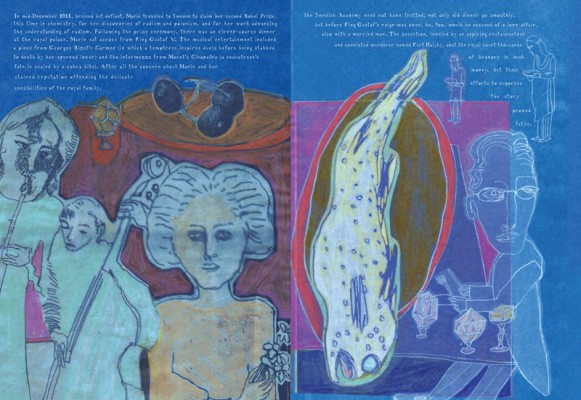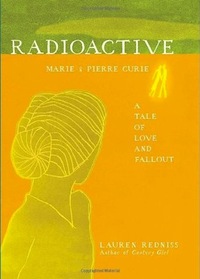Go Big Read marries art and science with “Radioactive”

The cyanotype images and luminous pages in the book “Radioactive” contribute to the emotional impact of a story about the human side of innovation and discovery.
Lauren Redniss was first drawn to Marie and Pierre Curie because of their beautiful love story.
But the Pulitzer Prize-winning illustrator found much more as she researched, wrote and illustrated her book “Radioactive: Marie and Pierre Curie, A Tale of Love and Fallout,” this year’s selection for Go Big Read, UW–Madison’s common reading program.

“Radioactive” tells the history of the Curies in a way never seen before. The book is an arresting mash-up of art and science, with cyanotype images and luminous pages contributing to the emotional impact of a story about the human side of innovation and discovery.
“I love it when they pick a book like this,” says John Hawks, an associate professor of anthropology who is also an artist.
For a previous Go Big Read title, “The Immortal Life of Henrietta Lacks,” Hawks taught a public course on what people can learn from their genome. He plans to use “Radioactive” in two different courses this semester, including an introductory biology class, and appreciates the way visual cues reinforce the story.
“I have students who are coming in from English, history — people that are not real science types — and to have something that personifies science and gives them an alternative way of getting into it is, I think, really valuable,” Hawks says.
Sharon Dunwoody, professor of journalism and mass communication, read “Radioactive” a year ago and became engrossed in the relationship between words and visuals in the book. This semester, she’ll use it in her science and technology journalism class as an example of how to communicate challenging material.
“This is a science writing class, and a book such as this has much to teach us about how to explain difficult concepts and processes using both words and visuals,” Dunwoody says.
“Marie Curie’s discovery is an important part of the history of science … but we’ve had an equal amount of interest from the arts, humanities and social sciences.”
Sarah McDaniel
For its fourth year, Go Big Read adopted a theme of innovation suggested by Interim Chancellor David Ward and “Radioactive” is a perfect fit, starting with its cover printed with glow-in-the-dark ink.
“The physical book itself, as a work of art, is most striking,” says Ed Van Gemert, interim director of UW–Madison’s General Library System. “A close second is the story, an interplay between art and science switching between past and present.”
Redniss is scheduled to visit campus October 15 and 16, including a public talk at Varsity Hall in Union South. Copies of “Radioactive” were distributed to first-year students at the Chancellor’s Convocation for New Students, and to students using the books in their classes. At least 60 courses will incorporate the book during the fall semester, in disciplines including French, genetics and psychology.
“We’ve had interest from courses across campus,” says Sarah McDaniel, program manager for Go Big Read. “Marie Curie’s discovery is an important part of the history of science and radium has contributed to advances in a number of fields, but we’ve had an equal amount of interest from the arts, humanities and social sciences.”
Nadine Connor seized on the chance to incorporate “Radioactive” into her introductory research course for graduate students seeking to become speech-language pathologists. “This book has a scientific theme obviously, but it goes beyond the science to the person,” Connor says. “It allows me to approach science as a human endeavor.”
Connor plans to form book clubs made up of a half-dozen students and meet individually with them at coffee shops to discuss “Radioactive” and offer extra credit to those who attend the author lecture scheduled for Oct. 15.
It has one other plus, too, she says. “I like the fact that it glows in the dark.”
To learn more and to sign up for email updates, visit the Go Big Read website.
